Intel Core 2 Duo E6300 & E6400: Tremendous Value Through Overclocking
by Anand Lal Shimpi on July 26, 2006 8:17 AM EST- Posted in
- CPUs
Application Performance using SYSMark 2004 SE
We'll kick off our look at general application performance with SYSMark 2004 SE and as always, we'll look at the overall score as well as the scores in each of the two suites - Internet Content Creation and Office productivity.
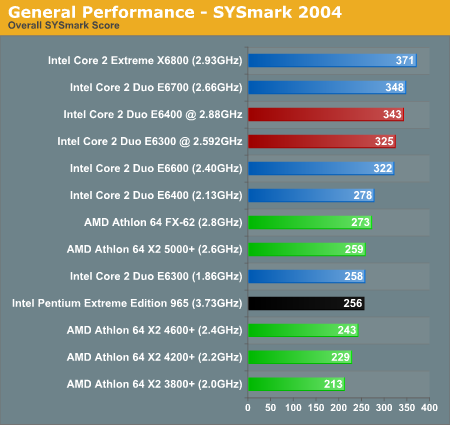
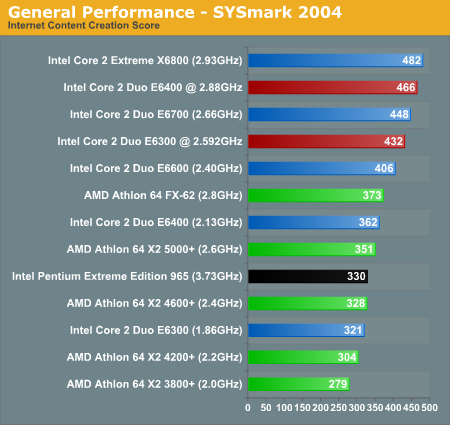
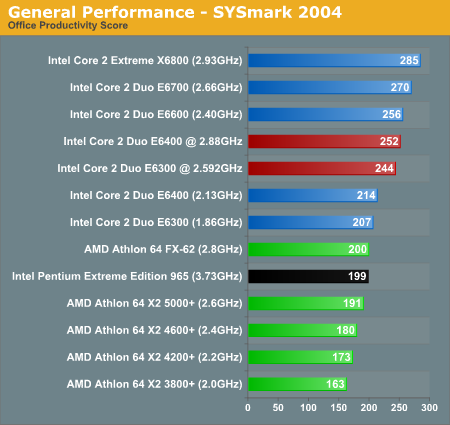
The applications tested by SYSmark 2004 cover the vast majority of the modern computing spectrum. Everything from multimedia to office to multitasking performance is included, and while not every application will show a substantial performance increase with a faster processor, the overall performance spread among the tested CPUs is almost 75%. If you routinely do a lot of computationally intensive work on your system (surfing the web and writing email generally don't count), there's no question that you will see a substantial difference between the fastest and slowest systems we're testing.
Our first look at the E6300/E6400 with overclocking generates some interesting results. There has been speculation that one of the reasons Core 2 Duo chips perform so well is that they have so much L2 cache. Dropping from 4 MB to 2 MB of cache does hurt performance a bit, but with a little bit of overclocking both of our budget Core 2 Duo chips perform very well. The net loss appears to be about 200 MHz, so the 2.88 GHz E6400 roughly equals the 2.66 GHz E6700, and the 2.59 GHz E6300 roughly matches the 2.4 GHz E6600. Drilling down into the individual benchmark results for SYSmark 2004, the impact of the reduced cache is more apparent in Office Productivity applications than it is in the Internet Content Creation results, but the 2MB Core 2 chips preform respectably regardless of the application being tested. Perhaps a Core 2 with 1MB or less of L2 wouldn't perform all that well, but since those parts don't exist there's no reason to worry about hypothetical bottlenecks right now.
Switching over to the AMD versus Intel comparisons, the E6300 and E6400 already compete very well, and once we throw in overclocking they are basically out of reach of any of the AM2 processors -- with or without overclocking. In overall score, the overclocked E6300 is almost 20% faster than the FX-62. A 20% overclock of the FX-62 (3.33 GHz) might close the gap, but it would certainly require more than stock air cooling, and it doesn't change the fact that we are able to get extremely good performance out of Intel's $180-$220 parts.
The individual SYSMark 2004 SE scores are graphed below if you're interested; the data is used in calculating the overall scores we've already discussed above:
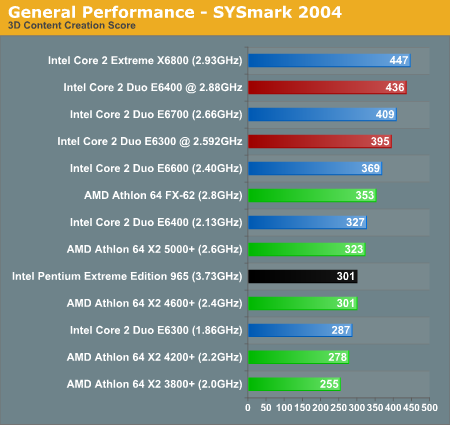
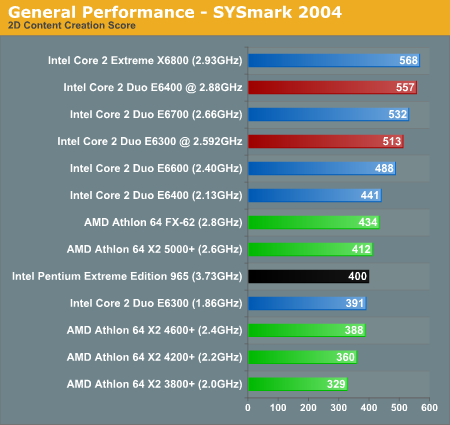

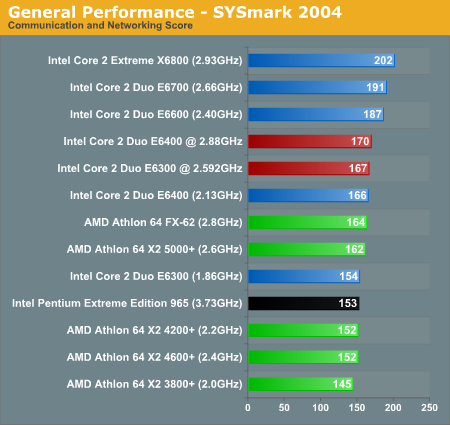
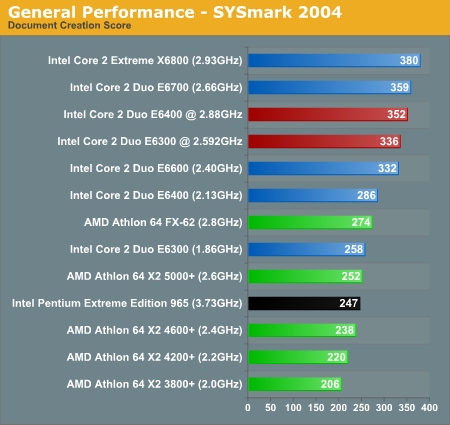
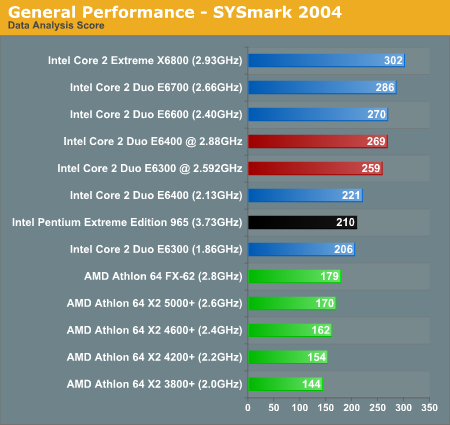










137 Comments
View All Comments
Gary Key - Wednesday, July 26, 2006 - link
Damn, Intel must have lost my address. ;-)
coldpower27 - Wednesday, July 26, 2006 - link
This is just so sad, how far AMD fanboys will go. I really wish there was moderation allowed, here the user point system is hardly effective enough.JarredWalton - Wednesday, July 26, 2006 - link
I'm pretty sure that was sarcasm, Coldpower. LOL :)coldpower27 - Wednesday, July 26, 2006 - link
Well, I guess my bad, though without a /sarcasm tag it's hard to tell. This is n't real life where you can here the tone of people's voices. :PSunrise089 - Wednesday, July 26, 2006 - link
You were unable to tell "the Magic Money Fairy" was sarcasm?Why not just come clean and admit that you didn't read carefully.
coldpower27 - Wednesday, July 26, 2006 - link
I read plenty carefully, thanks.Sunrise089 - Thursday, July 27, 2006 - link
Seriously?You were seriously unable to tell the following was sarcasm:
"...you all get weekly checks from Intel"
"...most Intel processors really don't even work at all"
"...Intel pays off the companies to say they're Intel Inside"
and of course
"the Magic Money Fairy."?
Dude, it's understandable that you were reading fast and thought the post was fanboy-ism, which there is indeed a lot of. Refusing to admit that and stating instead that the original (actually quite funny) post wasn't clear is insulting to that poster and frankly somewhat alarming.
coldpower27 - Thursday, July 27, 2006 - link
Your taking this way to seriously, if I can't recognize without smiley faces or a tag that it is sarcasm, it's acceptable considering this is written language. I rely on the tone of the conversation, which is absent here.
There is nothing to admit. There continues to be alot of AMD fanboyism at this site, even reading carefully, it sometimes isn't a simple task to deduce what is sarcasm from the rest of the fanboy drivel.
I am not refusing to admit anything, the poster should have considered this before he made the post, that not everyone will be able to catch the sarcasm, I assume the poster would have thought about this, and I already said my bad in the above post. You may think the establish indicators are sufficient for you, for me they are not.
Not everyone can percieve exactly the same things you can allright, and assuming otherwise is ridiculous in itself.
lewisc - Thursday, July 27, 2006 - link
lol - was a bit of a knee-jerk response, I thought the same thing until I read all the replies before, and then realised that it was indeed (hopefully!) sarcasm. You can't blame coldpower with the amount of rubbish being spouted by some users with how 'biased' this site is.VooDooAddict - Wednesday, July 26, 2006 - link
Nice to see you get your own article again from time to time, reminds me of when I started visiting AT.The following deals with the gaming performance question most people are asking. I understand that the true focus of the article is 2m Cache vs. 4m Cache and the Overclocking impact. E6600 is still at the top of my list for a powerful new SFF thanks to the article. Regardless the article has prompted the following:
(Maybe the following can be highlighted in a Budget/Midrange Gaming system buying guide...)
I think it's undeniably clear that the Core 2 Duo Chips offer the most headroom for future GPUs and should therefore be at the top of most gamers’ lists if they can afford it.
What I think some people may still find important is that with any of these amazing CPUs ... gaming is still GPU limited. It begs for the comparison of the E6300/E6400, the 3800/4200 X2, and 3500/3800 Single Cores. With a quality lower cost boards and single video cards like the 7950GX2 and 1900 XT. Do the lower end CPUs really limit gaming with a single card solution? I think the 7950 would also give a good showing as to if the new higher end and Dual Cores really needed for SLI, or if new new "low end" which used to be the high end are enough to keep that 7950 going. Most gamers I find at LANs still only run 1280x1024 without massive AA/AF simply due to the popularity of the cheep 17" and 19" sub 12ms LCDs. I also find a large number of gamers (who enjoy gaming but don't really spend much time enthusiastic about the hardware) don't ever turn on AA/AF.
I'm not saying you didn't state that most games are still GPU bound. You clearly tell gamers clearly in the article that it's probably best to buy the E6300 with a high-end video card then a E6600 and a mid range video card. I just think that it needs to be shown.